Video content has become the preferred recommendation for almost everything you do online. Writing a blog? Add videos to it. Have a podcast? Use videos to promote it. Want to expand your social influence? Video is the way to go. This comes as no surprise, considering that our daily consumption of digital video content continues to trend upward. According to Statista, people now spend over an hour each day watching videos. Videos are engaging, scroll-stopping, and relatable. Sometimes they entertain us, and other times they move us emotionally. With Facebook’s advanced, hyper-targeted advertising capabilities, Facebook video ads naturally become marketers’ not-so-secret weapon for capturing their ideal audience’s attention.
If you’re looking for guidance on creating a Facebook video ad, you’re on the right track. In this guide, we’ll walk you through the benefits, placements, best practices, and step-by-step instructions for creating videos and running a successful Facebook video campaign.
Why Should You Focus on Facebook Video Ads?
Facebook video ads are currently the most intuitive and effective advertising format. Not only do they showcase brand personality and emotional connections with the audience, but they also capture Facebook users’ attention. On average, viewers spend five times more time watching videos than static images. These engaged viewers are more likely to become effective customers, making video ads a powerful tool for expanding reach, increasing engagement, and boosting conversion rate.
Facebook is the King of Video Ads
In a recent study conducted by Wave.video on the state of social media advertising, Facebook has taken the lead through various measures. The research found that 92% of video creators produce content for Facebook, and 54% of respondents stated that ads on this platform receive the highest engagement. Additionally, 82% of participants claimed that their Facebook ads outperform those on other platforms.
Impressive, isn’t it?
Furthermore, viewers prefer Facebook over YouTube another social media giant when it comes to watching video ads.
So, what’s the conclusion? People appreciate relevant ads on Facebook, and video creators consistently choose this platform because their ads receive more engagement.
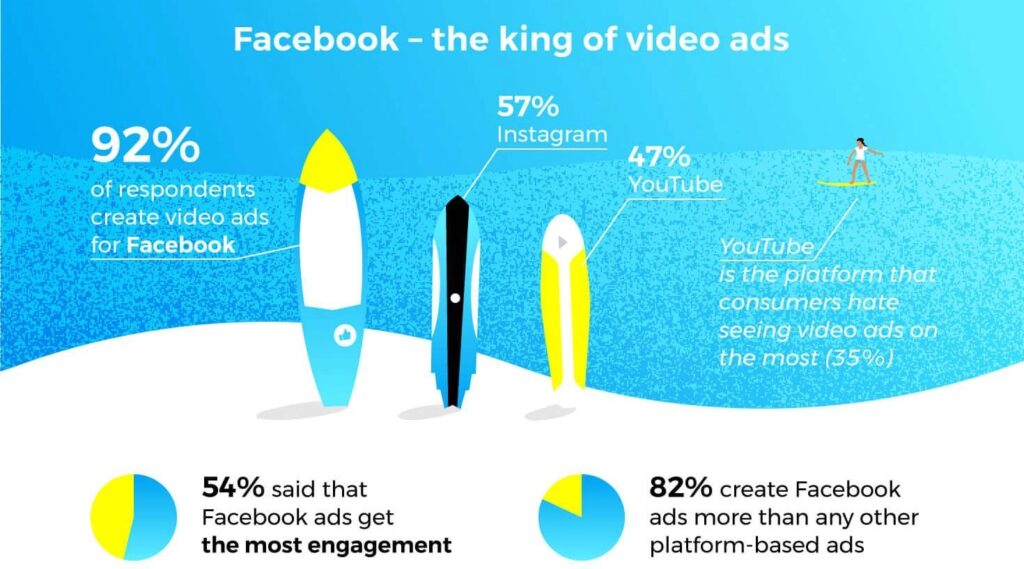
People want to see the actual effects of products
In fact, videos have a significant impact on people’s perception of products – quite a lot.
- Nearly 50% of internet users search for videos related to products or services before visiting a store.
- Four times as many consumers prefer watching videos about products rather than reading information about them.
Through Facebook video ads, you can appear where they expect you even before they start searching. Thanks to Facebook’s advanced targeting capabilities, your ads will be shown to consumers who are already interested in your product range and category—and this could influence their decision to research further or even make a purchase.
Videos Leave a Lasting Impression
According to data from Single Grain, 80% of users can recall video ads they’ve seen in the past 30 days. Imagine if your ideal customers see your Facebook video ads and remember them for a month—what results would you expect?
This could lead to more qualified traffic to your website, more leads, and even more customers. If your content resonates with your audience, videos can significantly impact your business.
Video Boosts the Highest Click-Through Rate
Now is the time to talk about marketing. The only way to determine whether your Facebook video ads are truly having a positive impact is by observing your audience’s actions after viewing.
Did they click? Did they like your page? Did they browse your website? Once you’ve identified direct user activity related to your business, you can track it and optimize accordingly. This is why videos play a significant role.
- Companies that use videos in marketing have a 27% higher click-through rate and a 34% higher conversion rate compared to those that don’t use videos.
- The average click-through rate for video ads is 1.84%, the highest among all digital ad formats.
Video Drives Valuable Customer Actions
Finally, even if you’re unsure about using videos as the right approach for Facebook ads, consider this:
- Videos aren’t just about getting clicks and views. They can also help people make purchasing decisions and ultimately part with their hard-earned money.
- For instance, if you use Facebook video ads to showcase and demonstrate a product, your audience might end up buying it—even if they weren’t inclined to do so before seeing the video.
- Even if your product is at a higher price point or targets businesses rather than consumers, videos can still attract them to your website and connect with your sales team.
- Never underestimate the power of video!
Remember, videos can significantly impact user engagement and conversions.
Where Can Facebook Video Ads Appear?
When we talk about Facebook video ads, most people automatically think of standard Facebook feed ads. However, these are all potential places where the same ad can appear:
- Facebook: News Feed, Instant Articles, in-stream videos, right column, Marketplace, Stories.
- Instagram: Feed, Stories
- Messenger: Home, sponsored messages
In Facebook terminology, these are referred to as placements. It’s essential to consider them early on because your ad placements are decisions you must make in your campaign settings before choosing formats or uploading videos. Facebook recommends opting for automatic ad delivery as it efficiently utilizes your ad budget. They optimize your ad delivery to achieve the lowest overall cost based on the goals you’ve defined for your campaign.
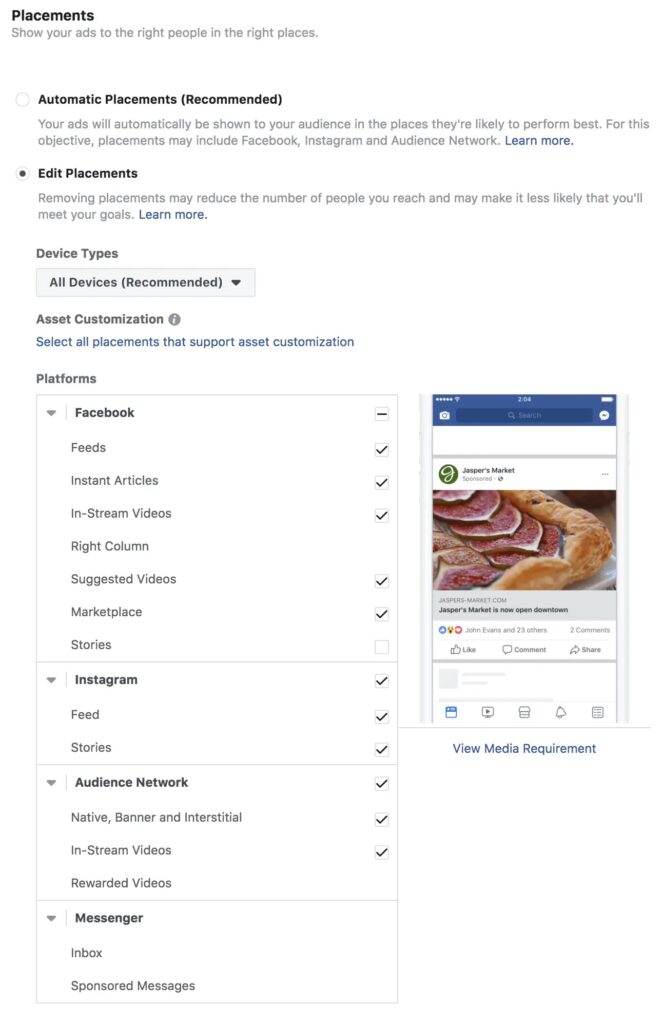
Remember, this will help you create a video that not only stops your audience as they scroll but also prompts action when they see your video.
Creating an Irresistible Facebook Video Ad
Facebook’s design recommendations for video ads include a wide range of options, but they aren’t entirely fixed.
For instance:
- Video aspect ratios can vary from 9:16 (completely vertical) to 16:9 (completely horizontal).
- Video lengths can range from 1 second to 240 minutes (yes, that’s 4 hours!).
- Subtitles and sound are optional but not mandatory.
- This diversity can be overwhelming, which is why we’ve broken down the key features of compelling Facebook video ads.
Convey a single message
The most crucial aspect of your video is that it should convey a single message.
Videos capture a significant amount of attention, so you might want to leverage them to share all the great things about your brand, product, or team. However, focusing on one powerful takeaway and action will yield a stronger impact.
Here are some themes you can focus on in your video:
- A super-specific tip related to a common question your audience has; the ad can lead viewers to a blog post listing more tips.
- Customer testimonials or similar proof of the success your product or service brings; the ad can direct viewers to a registration form or pricing page.
- A brief product demo showcasing your product in a real-world context; Facebook video ads can lead viewers to the product page.
- A behind-the-scenes video of your process and/or your team; the ad can take viewers to a brand story on your website.
As you can see, these serve different purposes, so it’s up to you to determine what goal you want to achieve through your video ad.
If you’re seeking inspiration, check out continually updated video template Facebook ads library, which covers various industries and themes.
Keeping Your Videos Concise
As I mentioned earlier, many Facebook video ad formats allow for up to 4 hours in length. While this provides flexibility and testing opportunities, it’s crucial to remember that video ads are easily skipped, so delivering the message in the shortest possible time is essential.
In fact, Facebook recommends experimenting with videos under 15 seconds. Considering the earlier tip about focusing on a single message, opting for a shorter format makes a lot of sense.
Additionally, research from BuzzSumo indicates that video engagement on Facebook starts to decline after 90 seconds.

Some video topics, such as quick tips, may work well in 12 seconds, while a brief product demo might require up to 1 minute to convey key points.
Show Your Product or Brand Information as Early as Possible
If you’re considering waiting until the end of your video to showcase your product, name, or logo, think again.
Facebook has consistently emphasized the need to hit people with faster information. In their video ad ratings, they found that ads with brand and information within the first 10 seconds can effectively reach three times as many viewers.
And to supplement the earlier point about the demand for short video ads, Facebook’s Chief Operating Officer, Sheryl Sandberg, stated that 6-second ads outperform 15-second and 30-second ads across overall brand metrics.
Want to be memorable? Appear as early as possible in your video!
Using Square or Vertical Formats on Mobile Devices
According to a Statista report, 95% of active user accounts access Facebook via smartphones. This is a positive trend! People are 1.5 times more likely to watch videos on their smartphones daily compared to computers.
To capitalize on this, focus on creating videos in square (1:1) and vertical (ranging from 4:5 to 9:16) formats. These videos will maximize screen real estate on mobile devices and help you avoid distractions from other Facebook feeds.
When producing videos, refer to the video requirements matrix to ensure your desired aspect ratio aligns with your advertising goals.

Additionally, experiments show that square videos yield the highest views, engagement, and coverage, especially on mobile platforms.
Creating Silent-Friendly Video Content
Up to 85% of video views on Facebook occur without sound. This makes sense because people watch videos during their commute, at work, or near sleeping children—where headphones might inconvenience those around them.
That’s why creating Facebook video ads that make sense even without sound is crucial. The information presented in the video should be visually clear and convey the next steps even after watching. You can achieve this by:
- Adding Text to Your Video: Incorporate text directly into your video to convey essential messages.
- Using Visuals for Narration: Tell your story through images, even when there’s no audio.
- Including Subtitles: Subtitles provide context and allow viewers to follow along without sound
Nailing Your Call-to-Action Position
Finally, your video should guide your audience to the next step through a compelling call-to-action (CTA). This could be subscribing to your newsletter, clicking through to your website or store, or even making a purchase. Whatever you choose, make it obvious and easy to follow.
Utilize all available elements, including text, arrows, and other visual cues, as well as voiceover (if applicable), to lead your audience seamlessly to that perfect next step. Another helpful tip is to consider the buttons you select when setting up your ad, such as “Shop Now” or “Learn More.” Additionally, play around with the placement of your CTA within the video. Wistia’s analysis shows that CTAs placed in the middle of the video perform better than those at the beginning or end.
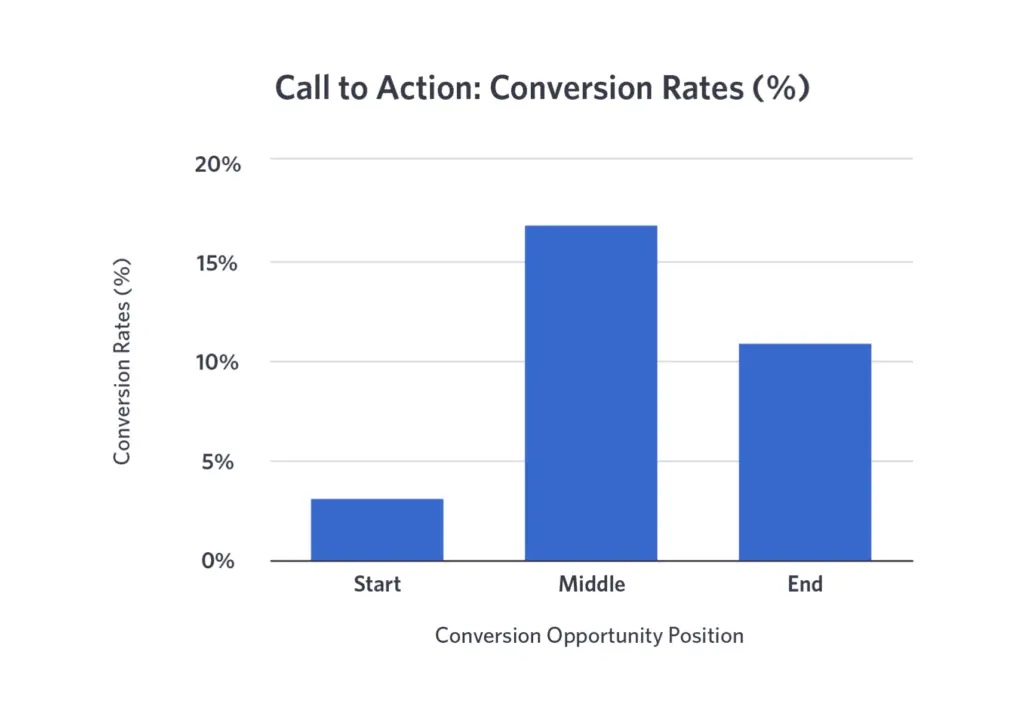
Test different options in your Facebook video ads to see which ones yield the best results.
Creating an Outstanding Facebook Video Ad
Are you ready to present your video to the right audience? Please follow these five steps.
Step 1: Getting Started in Facebook Ads Manager
Facebook Ads Manager is the starting point for running ads on Facebook, Instagram, and Audience Network. It provides everything you need, from intuitive guidance to a rich knowledge base.
If you’re just beginning or not very familiar with all the components of Facebook ad campaigns, a guided creation workflow will be highly beneficial for you.
Head over to Facebook Ads Manager and follow the steps to get started.
Step 2: Choosing the Right Objective
Once you start creating your campaign, you’ll be prompted to select your marketing objective, which will impact the rest of your campaign settings. While the video views objective might seem obvious for video ads, you can actually use video as your ad creative in nearly any of these objectives.
Rather than jumping straight into video, consider the following:
- Awareness Stage: This aims to reach people who are more likely to recall your ad later, sparking their interest in your brand and product.
- Consideration Stage: Target those who already know the type of solution they need and are currently evaluating all options (including your product as part of it).
- Conversion Stage: Focus on people who are already interested in your brand and product, enticing them to make a purchase.
As you can see, it’s not just about the number of views your video ad receives—it’s about the context and intent of your target audience.
Regardless of which stage and objective you choose, remember that Facebook will optimize your video ad delivery based on this. For example, if you want people to start conversations with you via Messenger from your video ad (the Messages objective), Facebook will show this video to people who have engaged with similar ads in the past.
Step 3: Find Your Perfect Audience
The Audience section in campaign settings allows you to highly customize who can see your Facebook video ad. This includes applying the following filters:
- Location (country and region)
- Age (you can set minimum and maximum age)
- Gender
- Language
- Detailed targeting, including demographics, interests, and behaviors—you can include or exclude specific details.
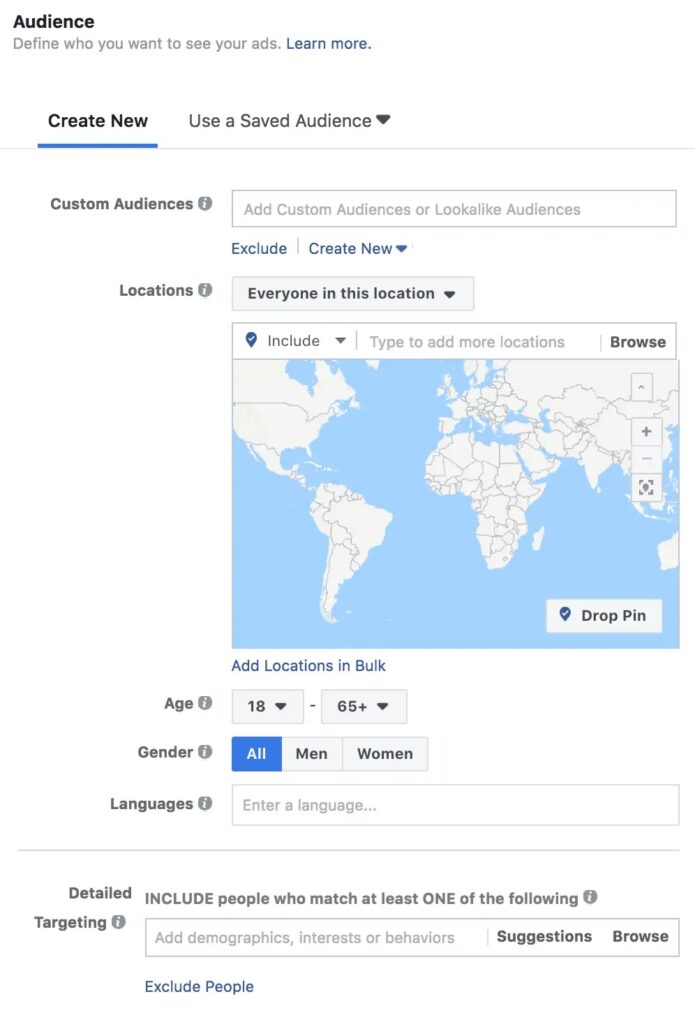
You can also create custom or lookalike audiences by uploading your subscriber or customer lists. Once you’ve defined your targeting, you’ll see daily reach estimates and results. You can also save your audience for future campaigns.
Step 4: Let Facebook Guide You to What Works Best
Depending on the format and placement you choose, Facebook will recommend the most suitable length, aspect ratio, resolution, and file size.
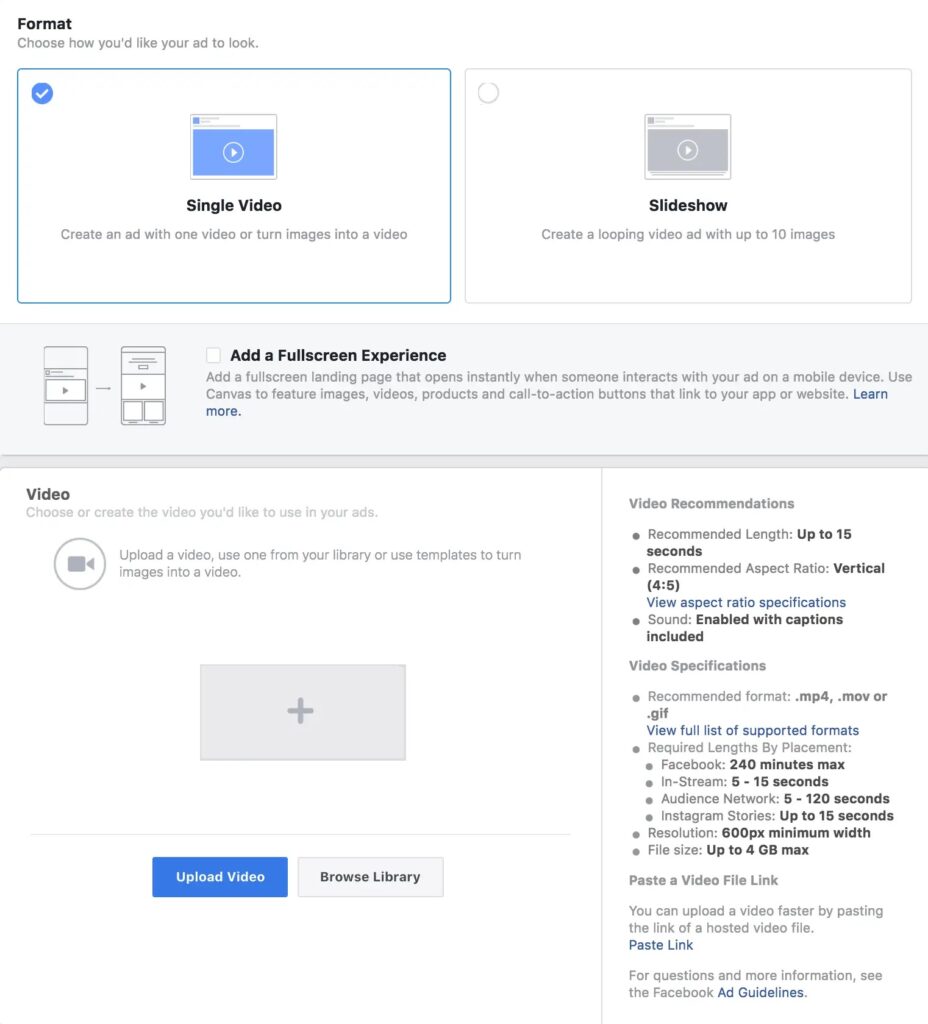
Be sure to check the aspect ratio specifications, supported formats, and ad guidelines to ensure you meet all requirements.
Step 5: Refine Your Ad Copy
The text you include in your video ads should complement the message you convey in the video and prompt viewers to take action.
To ensure this, keep the following recommendations in mind:
- Text Length: Limit your text to 125 characters or less to avoid truncation.
- Link Titles: If you add links in your ad, make sure the titles are no longer than 25 characters.
- Link Descriptions: Keep link descriptions under 30 characters.
- Thumbnail Text: Be cautious when adding text to your thumbnail image. If the text in the image exceeds 20%, it may negatively impact ad delivery.
Remember, concise and compelling ad copy can significantly improve your campaign’s effectiveness!
Step Up: It’s Your Turn!
Congratulations! You’re now well-prepared for successful Facebook video ads. Let’s quickly recap the key takeaways and steps:
- Memorable Branding: Showcase your products and brand through Facebook videos, leaving a lasting impression and compelling your audience to take action.
- Dynamic Short Ads: Short, dynamic video ads with a clear Call to Action (CTA) perform best.
- Goal Alignment: In Facebook Ads Manager, choose a marketing objective that aligns with your business goals to optimize your ad performance.
- Enjoy the Process: Have fun creating Facebook video ads, and let your business thrive on the foundation of your success!
